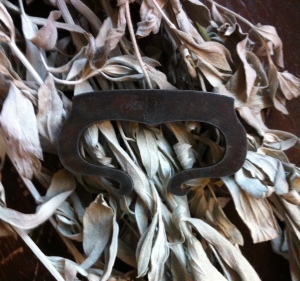Making Fire
One day several weeks ago, a friend handed me this:
He had previously told me that he had a gift he wanted to pass to me for participating in a harvest gathering conference where I shared what I’ve learned about dancing and winnowing manoomin (rice).[1] He passed this to me at the beginning of a class we are both in so I didn’t have time to ask him what it was. I did have time to admire it though.
I had no idea what it was. I figured it was a kind of tool. I wondered if it was used for twine in some way because why not? I’ve read that twine was a staple in various treaties.[2] Seriously. Twine.
Then I wondered if it was a template for a design of some kind. I recalled seeing templates made of wiigwaas (birch bark) for beading. The shape of this item reminded me of some old time designs.[3] Recalling this, I actually started using it to trace designs on my notebook. Some of the corners were too small for my pencil so that was a fail.
Well, at the end of that class I was able to ask him what it was.
Me: So, what is this?
Caleb: A flint and steel striker, handmade from steel.
Me: *smiles* Ah! Awesome! Miigwech!
A tool for making fire is a great gift, especially for women. I was elated all day! Every woman needs to know how to make ishkode (fire); every person. The knowledge, skill, and tools to make fire is something everybody needs to know. This is practical and pragmatic for all kinds of reasons. My dad first taught me how to make fire in the woodstove as a kid. Making fire was something I also learned to do when we would go in the bush with his friends and their kids to cut wood; fire would be made to cook up lunch. My memories also include me and a friend going into the bush behind my house in the winter as children. We’d clear out a space in the snow, gather birchbark and dry wood, and make fire there amongst the evergreens, maples, and rocks jutting out here and there. We’d sit back and have something to eat and enjoy everything around us, including out friend. Making fire…I grew up with it. I taught my daughter to make her first fire at the sugar bush in 2011. She was nine-years old:
Everyone had gone their way for the day and we there finishing up a boil into the late afternoon. It was the first time we worked alone in the few seasons we’d been there. In the quiet of just her, me, aandegag (crows), and the boiling sap, she asked,
“Mom, can I make a fire?”
“Yes, of course. It’s a good time to learn.”
And so, make a fire she did. She still does.
Making fire is now a part of her bundle. It’s a very important part of her bundle because not only did she show herself that she knew how to make fire, she learned that ishkode has a spirit, is a friend. Whenever everyone leaves and it is really quiet or whenever you are alone, making a fire somehow soothes it, making a fire is like making a friend in the space you are in. Even though I’m still learning how to use it, this flint strike is a now part of my bundle.[4] I think of it as Anishinaabe bling, or, my kind of ring!
Note: Caleb has been working on the land for a long time. To find out more about what he does, please check out his website, http://www.canadianbushcraft.ca/
[1] Harvest Gathering, https://www.facebook.com/events/154151724795013Harvest Gathering, /?previousaction=join&source=1
[2] As example, from the Canadian version of Treaty 3: “GOVERNOR – ‘I thought I had spoken fully as to everything, but I will speak again. The ammunition and twine will be got at once for you, this year, and that will be for every year.” Morris, Alexander, The Treaties of Canada with the Indians (Toronto: Prospero Books, 2000; originally published Toronto: Belfords, Clarke, 1880), p. 69. Important note: As descendent of this treaty, I’ve never received ammunition or twine. A minor yet significant example of how Canada has not followed through on its word.
[3] While being aware of the limitations that exist in anthropological sources of Indigenous lives, I find value in these sources. Being elements of debwemigad (truth), they inform my thinking about our ancestors’ lives and infuse imagination. I’ve been introduced to Anishinaabeg designs as our ancestors created them in Densmore, Frances, Chippewa Customs (St. Paul: Minnesota Historical Society Press, 1979). Interesting publication technicality—in this text, there are ten pages of beading designs included however the pages are not numbered; the pages with images of designs exist between the written text numbered p.186-189.
[4] Ojibway Anishinaabeg Gichi Piitzijid Peter Migwans first taught me about bundles. Opening up his, he laid everything out carefully. He gave teachings to a group of us about the medicines—asemaa, wiingaashk, mishkodewaashk, giizhigaatig. It was a long time ago that I learned about these things but essentially he said that these medicines didn’t belong to him, this bundle was not his, and none of what was there was his. This bundle belonged to the community. He said that he did not own this bundle but he had the responsibility to care for it and put it to use. Personal communication, 1997, Bawating (Sault Ste. Marie, ON). I share this dibaajimowad (personal story) to give understanding to the possessive language used around bundles in this section (e.g. her bundle, my bundle).


